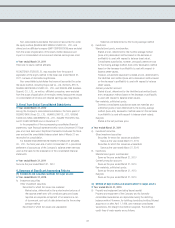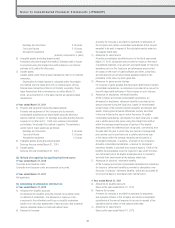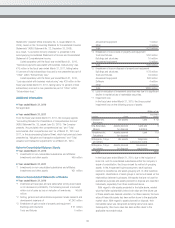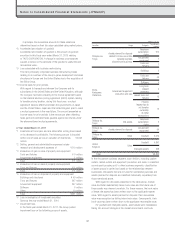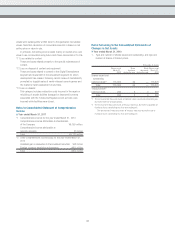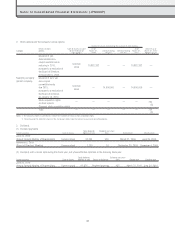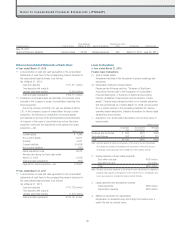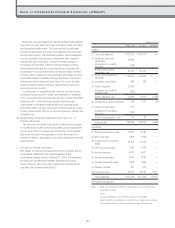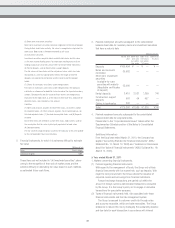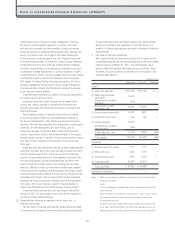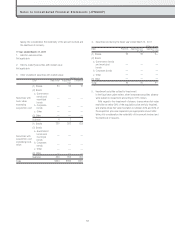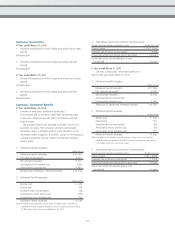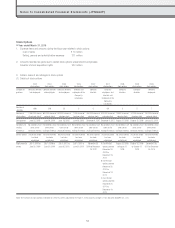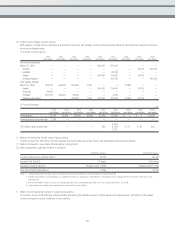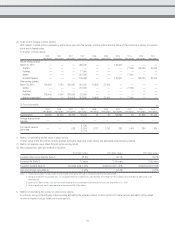Square Enix 2011 Annual Report Download - page 49
Download and view the complete annual report
Please find page 49 of the 2011 Square Enix annual report below. You can navigate through the pages in the report by either clicking on the pages listed below, or by using the keyword search tool below to find specific information within the annual report.
(Impairment loss)
No impairment loss was recognized on leased assets.
Operating lease transactions
Future lease payments on noncancellable leases:
Due within one year ¥1,070 million
Due after one year —
Total ¥1,070 million
■ Year ended March 31, 2011
Finance lease transactions
(1) Type of leased assets
Same as the year ended March 31, 2010
(2) Depreciation method for leased assets
Same as the year ended March 31, 2010
1. Acquisition cost, accumulated depreciation and net book value of
leased assets:
Millions of yen
Acquisition Accumulated Net book
cost depreciation value
Buildings and structures ¥425 ¥390 ¥34
Tools and fixtures 218 160 58
Total ¥643 ¥550 ¥92
Note: Same as the year ended March 31, 2010
2. Ending balances of future lease payments:
Due within one year ¥67 million
Due after one year 24 million
Total ¥92 million
Note: Same as the year ended March 31, 2010
3. Lease payments and depreciation expense:
Lease payments ¥175 million
Depreciation expense ¥175 million
4. Method of calculation for depreciation
Same as the year ended March 31, 2010
(Impairment loss)
No impairment loss was recognized on leased assets.
Operating lease transactions
Future lease payments on noncancellable leases:
Due within one year ¥655 million
Due after one year 124 million
Total ¥779 million
Notes Regarding Financial Instruments
■ Fiscal year ended March 31, 2010
1. Matters concerning financial instruments
(1) Policies regarding financial instruments
With regard to the management of funds, the Group only utilizes
financial instruments with low market risk, such as deposits. With
regard to fund procurement, the Group utilizes the issuance of
corporate bonds and borrowings from financial institutions.
Forward-exchange transactions are carried out within the
amount of foreign currency-denominated transactions conducted
by the Group. It is the Group’s policy not to engage in derivative
transactions for speculative purposes.
(2) Types of financial instruments held, risks associated with those
financial instruments and the risk management system
The Group is exposed to customer credit risk through notes
and accounts receivable, which are trade receivables. The Group
endeavors to reduce this risk by managing the outstanding balance
and due date for each transaction in accordance with internal
rules at each Group company for sales management. Owing to
the Group’s global business operations, a portion of its notes
and accounts receivable are denominated in foreign currencies,
which are exposed to exchange rate fluctuation risk. Although the
Group, in principle, does not engage in derivative transactions,
for the purpose of hedging against the risk of future fluctuations
in foreign-exchange rates, it enters into forward foreign exchange
contracts from time to time. Although forward foreign exchange
contracts involve exposure to exchange rate fluctuation risk, each
counterparty to these transactions is, without exception, a highly
creditworthy bank. Hence, the Group judges that credit risk through
counterparty breach of contract (counterparty risk) is negligible.
With regard to forward foreign exchange transactions, all risk is
centrally managed by the accounting division under the approval
of a representative director and the director assigned to oversee
accounting and finance matters.
Short-term investment securities are held in the form of
negotiable certificates of deposit, and the market price fluctuation
risk associated with these instruments is extremely low. Investment
securities mainly comprise stock market listed shares, and, hence,
exposed to market price fluctuation risk. However, fair values are
monitored and regularly reported to the Board of Directors.
Rental deposits consist of deposits required to be furnished
by the Group when it enters into real estate leases relating to
the Group’s headquarters, other offices and amusement arcade
facilities. Construction support deposits consist of deposits
furnished by the Group in relation to amusement arcade leases.
Although these deposits involve exposure to counterparty credit
risk, for the headquarters and other offices and amusement
arcades, the general affairs division and sales division with
the Group confirm the creditworthiness of the lessors through
regular contact with the respective counterparties. In addition,
the accounting division checks with each of these divisions on the
situation at the end of each fiscal year.
47


